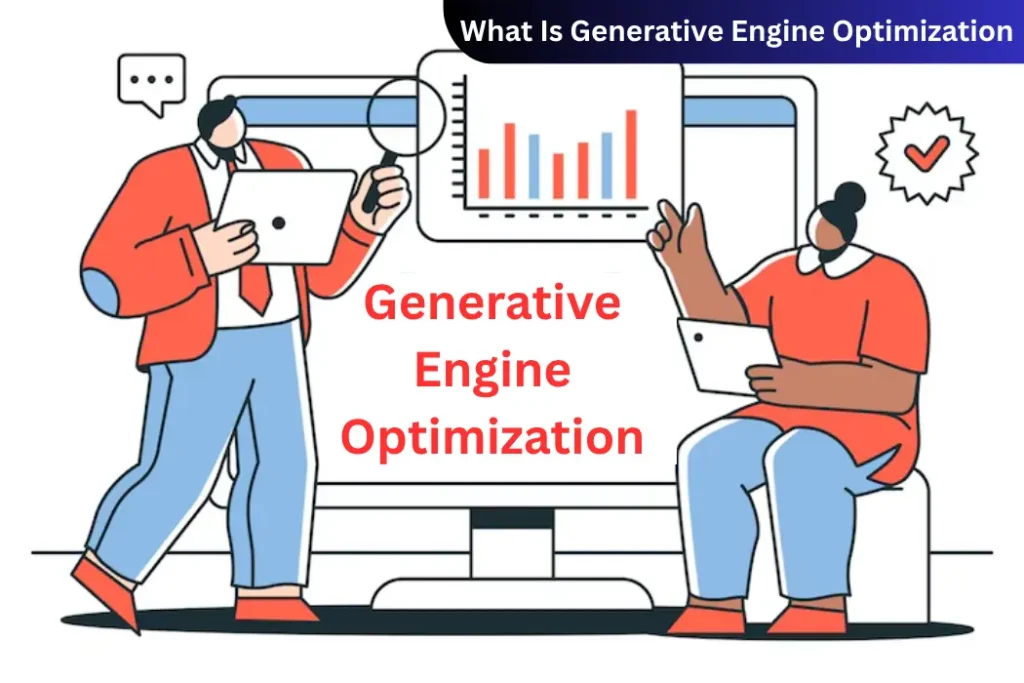Generative Engine Optimization (GEO) is the strategic process of tailoring your content to be discoverable, credible, and referenced by AI-driven generative engines such as chatbots, large language models, and conversational search systems rather than by traditional search engines alone.
Unlike traditional Search Engine Optimization (SEO), which focuses on ranking web pages on Google or Bing, or Answer Engine Optimization (AEO), which targets concise, voice-friendly answers, GEO goes a step further. It optimizes your content so that AI systems can interpret, summarize, and cite it accurately in their conversational responses.
When users ask AI questions like, “What’s the best way to start a blog?”, generative engines pull insights from multiple sources and synthesize them into human-like answers. GEO ensures your content is structured, detailed, and authoritative enough for those engines to prioritize and reference it.
Why GEO Matters
As AI-driven tools become the default information channel, GEO has emerged as a critical component of digital visibility.
Key Reasons GEO Is Essential
- Shift in User Behavior: Millions of users now rely on AI chatbots instead of search engines for answers to complex, conversational queries.
- New Visibility Channels: It is no longer enough to appear in Google results. Your brand must also appear in AI-generated answers.
- Competitive Advantage: GEO is still new, giving early adopters a strong edge in brand visibility and credibility.
- Future-Proofing: As generative AI integrates real-time and multimodal capabilities, GEO ensures your content remains relevant across new discovery platforms.
For More Information Read Our Blog :- Traditional SEO vs Generative SEO
Step-by-Step Guide to Implementing GEO
Step 1: Conduct Competitor and Prompt Landscape Analysis
Before crafting GEO-ready content, analyze your competitive landscape and audience behavior.
Actions to Take:
- Identify direct and indirect competitors whose content appears in AI-powered engines.
- Study how users phrase conversational queries (e.g., “How do I start a sustainable garden at home in 2025?” instead of “sustainable gardening”).
- Understand search intent, whether users are looking for tutorials, comparisons, expert opinions, or predictions.
- Analyze how top competitors structure their content, including headings, schema, lists, and multimedia usage.
This research ensures that your content aligns with how both users and AI systems consume information.
Step 2: Create In-Depth, Context-Rich Content
Generative engines prioritize content that provides value, depth, and context rather than superficial keyword stuffing.
Best Practices:
- Answer Completely: Explain the what, why, and how. Include real-world examples and case studies.
- Use Natural, Conversational Language: Write as though you are speaking to an intelligent reader, not a search engine.
- Tell Stories: Relatable examples make content more memorable and easier for AI to reference.
- Show Expertise: Use credible data, research insights, and professional commentary to reinforce authority.
- Add Keywords Naturally: Integrate relevant phrases like Generative Engine Optimization, AI content optimization, and GEO strategy seamlessly.
Quality content helps AI models identify your brand as an authoritative source, increasing citation potential.
Step 3: Structure Content for AI Processing
Generative engines rely heavily on structured, easy-to-parse content.
Optimization Tips:
- Use clear, question-based headings like “What Is GEO?” or “How to Optimize for Generative Engines.”
- Break down complex topics using bullet points and numbered lists.
- Implement structured data such as FAQ and How-To schema to help AI understand context.
- Place key information early in each section to ensure higher visibility during AI summarization.
- Use logical internal linking and simple navigation to make contextual relationships between topics clear.
A clean, semantic structure improves both human readability and AI interpretability.
Step 4: Build Authority and Credibility (E-E-A-T Aligned)
AI systems prefer content that is produced by reliable and authoritative sources that can be verified. One way to establish authority on the net:
How to Build Authority:
- In content provide the sources to the studies, credible statistics, and industry experts, if it is feasible.
- Have authorship and publication date always available for everyone to see, so that trust is built up.
- Keep on updating your content with new ideas and examples from time to time.
- Do not use keywords artificially or over-optimize. Give first priority to naturally flowing, valuable information.
- Get backlinks and mentions from domains that are respected to bring up the trust level of your content.
Authority signals have an increasing influence on GEO as AI models give weight to source reliability when they decide where to take their citations from or which content to summarize.
Step 5: Integrate Multimedia and Multimodal Elements
One aspect of generative engines is that they are becoming multimodal: they can process texts, pictures, videos, and sounds.
Multimedia Tips for GEO:
- Write an informative alt text for each image to clear up the context.
- Provide the transcript of a video or a podcast so that AI systems could have access to the data that they are to index.
- Use infographics or visual summaries to attract visitors and inform AI.
- Make videos and images SEO friendly by including video or image Schema markup.
By converting your material into different formats, you make it available to both humans and AIs on various platforms.
Step 6: Monitor and Adapt Your GEO Strategy
GEO needs just as much work, if not more, than SEO, and demands continuous checking and adjustment.
How to Stay Ahead:
- Check the visibility of your content in AI tools by looking for mentions, citations, or AI-summary inclusions.
- Analyze competitor activities, and understand which styles or formats of communication the AI utilizes most.
- Try new content formats like Q&A, long-form guides, or expert roundups.
- Be aware of the latest AI trends taking place such as retrieval-augmented generation (RAG) and real-time content integration.
- Keep on updating and extending the current articles in order to be recognized as the authority of the topic.
Continuous optimization is the key to keeping up with the changes of AI algorithms in the long run.
Frequently Occurring GEO Errors That Should Be Avoided
- Not paying attention to the intent of the user and conversational context.
- Producing thin or repetitive content with minimal depth.
- Improperly structuring pages so that AI cannot easily get the gist.
- Concentrating on keywords alone instead of the value and meaning of content.
- Failing to make regular content updates and trend monitoring.
Top GEO Trends and Technologies
With the continual advancements of generative AI, which in turn significantly alters users’ methods of discovering and interacting with data, Generative Engine Optimization (GEO) is fluctuating at a rapid pace. Companies that grasp the forthcoming changes will be able to strategically place their materials for maximum exposure, dominance, and interaction throughout AI-driven search platforms.
The top GEO trends and technologies that are influencing 2025 and how you can use them to keep up with or outsmart your rivals are presented below in detail.
1. Multimodal Optimization
Overview:
Generative engines such as ChatGPT, Gemini, and Claude are not only confined to providing text-based results. They are upgrading their capabilities to become multimodal, which means they can understand and create content via text, images, videos, and even audio. This permits AI machines to produce more extensive, user-friendly solutions to requests that use a combination of different content formats.
Why It Matters:
The usage of only text content in a multimodal setup significantly lowers the probability of your brand being presented in AI-generated results. The AI-powered devices are more and more often extracting the needed data for their answers from visually presented content such as infographics, videos, and images rather than from the text.
Actionable GEO Strategies:
- Present informative visuals such as infographics, charts, and diagrams that comprehensively explain the content of your writing.
- Implement optimized alt texts as well as image captions that not only describe but also explain content in a way that it can be easily understood by AI.
- If the content is video-based, then it is a wise solution to provide transcripts along with closed captions as well, so that AI solely focused on text can also access the content of the video.
- Use VideoObject and ImageObject markup so that search engines can easily access the information in your audio-visual content.
- Topic-related short-form and long-form multimedia (e.g., an explanatory video accompanying a “How-To” article) can be used for better user engagement and higher search engine ranking.
Example:
A business creating content about “Generative Engine Optimization strategies” can prepare an infographic illustrating the GEO process. In the case, if the AI tools are looking for the relevant images that can enrich their responses, that picture might be referred to or quoted, which in turn leads to the increased branding.
2. Real-Time Data Integration (RAG)
Overview:
Currently, AI models are transitioning from relying on fixed datasets to fetching real-time, on-demand data with the support of RAG (Retrieval-Augmented Generation) techniques. In other words, generative engines are not limited to working only with pre-trained data since they can also obtain the most recent information from web sources and only then generate their response.
Why It Matters:
RAG radically transforms the content world. The out-of-date data or dead-end pages will get less and less attention as AI engines look for the freshest and most accurate contextually relevant resources.
Actionable GEO Strategies:
- Regularly bring in new content through fresh insights, trends, or data points. Pages that have not been updated for a long time are less likely to be featured in AI-powered responses.
- Introduce dynamic content components or auto-updating data widgets (e.g., live statistics or updated case studies) with the purpose of retaining content freshness.
- Keep publishing and update timestamps to indicate that your content is up-to-date.
- Frequently publishing industry insights, quarterly reports, or trend articles will not only help you to be recognized as an active but also as a reliable source of data.
Example:
In case you are maintaining a blog post titled “AI Trends in Marketing 2025,” it is necessary to have a section for the quarterly statistics that is always up-to-date. With RAG, generative engines are able to get the most recent data, thus your visibility in the real-time summaries is increased.
3. Entity-Based and Semantic Content Modeling
Overview:
Generative engines are less and less dependent on the use of keywords. They now employ semantic understanding as well as entity-based content modeling to figure out the ideas, concepts, and relationships. Entities are topics or objects that can be identified (for example, “GEO,” “AI content optimization,” or “Google Gemini”) and that enable AI to grasp the features of your content.
Why It Matters:
Now that semantic relevance is more important than exact keywords, AI models look into topic clusters, the connections between concepts, and the contextual source to decide which content best answers a query.
Actionable GEO Strategies:
- Instead of one blog post focusing on one topic, create topic clusters. The primary pillar page (e.g., “Complete Guide to GEO”) can be linked with subtopics (e.g., “GEO vs SEO,” “How to Optimize for Generative Engines,” “AI-Powered Content Strategies”) by you.
- Apply semantic keywords and related terms in your article in a natural way. Also, you may use Clearscope or SurferSEO to identify semantic patterns.
- Internal links help both users and AI to navigate through the topics of your site that are interconnected.
- The use of structured markup (schema) which specifies entities such as organizations, authors, and content type is quite helpful.
Example:
The article about “GEO Trends 2025” should also talk about close entities like “AI Chatbots,” “Retrieval-Augmented Generation,” and “Multimodal AI.” By doing this, your AI model is informed that your content comprises interlinked topics in-depth, hence, it is more likely to be included in AI-generated summaries.
4. Structured Data Evolution
Overview:
Structured data or schema markup is a technical tool that is very important for both SEO and GEO. Its role is to provide help to search engines and AI models in understanding content and its hierarchy.
Why It Matters:
To determine context, relationships, and purpose, AI systems as they become more advanced, rely more on structured cues. Schema that is put in the right way makes your content doable by machines and less difficult for AI to get and rank.
Actionable GEO Strategies:
- Where the conditions are right, employ Article, FAQ, HowTo, and VideoObject schema types.
- Support the transparency and trust by adding Author, Organization, and DateModified metadata.
- Use Breadcrumb schema to indicate the page hierarchy and the relationships of the content.
- JSON-LD markup can be used to give AI models a better idea of the content structure in question.
- Make sure your schema is perfect through various testing instruments such as Google’s Rich Results Test or Schema.org validator.
Example:
A blog post optimized for the GEO on the topic ‘AI Marketing in 2025’ with the inclusion of FAQ schema and correct metadata will be more easily picked out by AI engines as a reliable source for user queries that are relevant.
5. First-Mover Advantage
Overview:
Since GEO is still in its infancy, a select few who are quick to see the potential and take action have the opportunity to rule the generative engine results before the competition becomes saturated. Similar to the initial stages of SEO, the brands that make the investment now will be the ones that reap the benefits of the most prolonged visibility and recognition within AI-generated ecosystems.
Why It Matters:
Generative AI platforms are in the process of expanding their data ecosystems. Securing authority at the beginning raises the chances that your content will turn into the main reference material for AI systems.
Actionable GEO Strategies:
- Publish articles that demonstrate your expertise in the industry and original research about your niche topics.
- Besides keyword ranking, make your content the perfect fit for AI summarization.
- Work on comprehensive guides and evergreen resources that AI systems can use time and time again.
- Be the first to claim digital real estate for conversational keywords that have high commercial value.
- Keep on evaluating competitors who are already being cited by AI systems and make changes in your content accordingly.
Example:
A technology firm that takes the initiative to publish an extremely thorough “Ultimate Guide to Generative Engine Optimization” may become one of the most referenced sources in AI-generated discussions about GEO for a long time.
6. Reduced Click-Dependence and the Rise of AI Mentions
Overview:
SEO traditionally involved users clicking on links to get their answers. However, AI-based systems are progressively able to give full responses within the conversational interface itself, thus the standard click-through model is losing its relevancy. The new game is not only to attract users to your site, but also to be the source that the AI refers to when generating its responses by mentioning your brand, expertise, and insights.
Why It Matters:
AI being the new norm for access to information, the question of visibility is not only about traffic but also trust and influence. If your company is the one that is most often referred to in AI conversations, then you get the benefits of more exposure, more authority, and more recognition, even if there is no direct traffic coming to your site.
Final Summary
Generative Engine Optimization (GEO) is a manifestation of cutting-edge artificial intelligence, cleverly devised content strategies, and digital marketing coming together.
The steps to keep ahead are:
- Brand voice consistency and content trustworthiness are most important to ensure that your texts will be cited.
- Make sure that personal author and business profiles are not only well-crafted but also real and open.
- Break down the answers into brief, clear sentences within your lengthy articles to facilitate the AI in picking them out.
- Developing FAQ sections that contain standard questions from your area of expertise will help you to be chosen for snippets.
- AI-monitoring tools will be available for you to keep track of your brand mentions in generative search summaries as the technology is evolving.
Example:
For example, a digital marketing agency might realize that the AI systems tasked with responding to user queries are literally quoting its definition of “GEO”. What this means is that brand awareness, authority, and organic trust is being ‘crafted’ even in the absence of clicks.
Final Thoughts
Generative Engine Optimization (GEO) is the major factor that is changing the way digital visibility operates. AI is becoming the new front door to information and therefore businesses and content creators have to adapt.
You position your brand as a trusted source for AI systems by competitor analysis, content creation that is deep and well-structured, authority building, and by the use of multimedia. Incorporating GEO into your digital strategy is like putting a content visibility, influence, and future-readiness shield on content in the era of generative search.
If you want to be found by the next generation of AI-powered discovery, then start optimizing for GEO now.
FAQs on Generative Engine Optimization (GEO)
1. Why is Generative Engine Optimization important?
GEO is important because it helps your content get cited and referenced by AI systems like ChatGPT and Gemini. It boosts brand visibility, credibility, and trust in AI-generated answers.
2. Is Generative Engine Optimization the same as traditional SEO?
No. Traditional SEO targets search engine rankings, while GEO focuses on making content understandable and reference-worthy for AI-driven engines.
3. How do I improve my Generative Engine Optimization?
Create detailed, credible, and well-structured content. Use schema markup, add multimedia, and update regularly to help AI systems recognize your authority.
4. How to optimize for Generative Engines?
Use conversational language, clear structure, and relevant entities. Include visuals, alt text, and schema to make your content easier for AI to interpret.






